
JAMES R. ARNOLD
TET OFFENSIVE 1968. TURNING POINT IN VIETNAM
Within fifteen minutes of the first attack, an Associated Press (AP) reporter had typed out the first bulletin announcing the attack. By a twist of fate that was to have immense consequences, the embassy was close to the quarters housing the Western Press. This allowed reporters to rush to the scene of the action. The resultant concentration of the Press undoubtedly distorted the significance of the combat. Because they could not see over the walls, neither they nor the soldiers knew what was going on inside. Consequently they relied upon the excited comments of one of the MPs who was outside the walls. This MP stated: 'They're in the embassy.' When a reporter asked an MP captain for confirmation, he replied: 'My God, yes... we arc taking fire from up there... keep your head down.' This information was sufficient for AP to send a bulletin stating:
'The Vietcong seized part of the US Embassy in Saigon early Wednessday... Communist commandos penetrated the supposedly attack-proof building in the climax of a combined artillery and guerrilla assault that brought limited warfare to Saigon itself.' This bulletin arrived just before the first-edition deadlines for very influential morning newpapers in the eastern USA. Headline writers quickly updated their papers and spread the shocking message that the enemy had captured the symbol of American prestige.
In Saigon, the American command failed to appreciate the importance of the embassy combat. The commander on the spot was quite content to wait for daylight before proceeding. He knew he had the VC cornered. At higher command levels the numerous actions exploding all over the country seemed to demand more attention. Responding to pressure from Washington, around 5am Westmoreland had Weyand send a helicopter with a platoon of airborne soldiers to land on the embassy roof. Automatic weapons fire from the surviving VC drove it off. To avoid unnecessary risks, the higher command decided to wait for daylight before trying again. By the time the helicopter returned, MPs had forced the embassy gate. They easily killed the few surviving VC. What an American participant called 'a piddling platoon action' was over after a six hour combat.
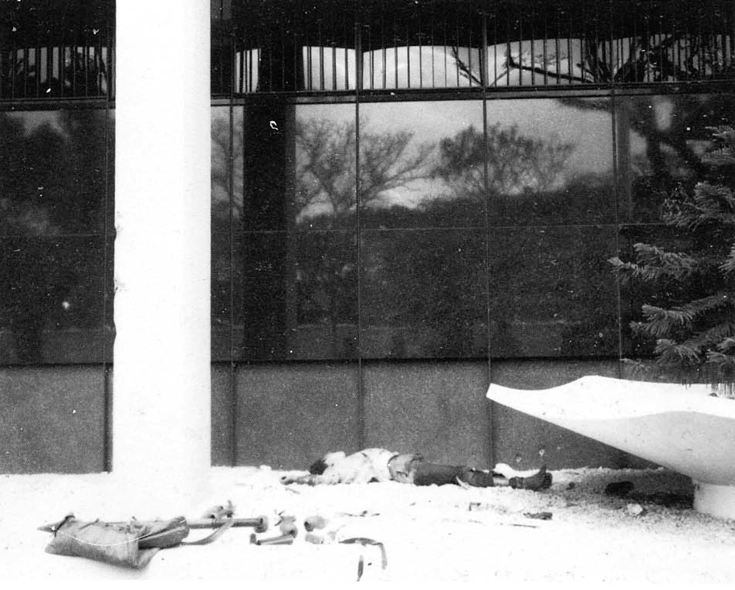
A dead VC next to a landscape planter inside the embassy compound. His rocket launcher and equipment lie nearby.
Reporters swarmed the grounds as military spokesmen tried to explain what had happened. Controversy centred on whether the VC had actually entered the embassy. Although they had not technically entered the embassy building, the AP stood by their opposing claim. Too often reporters had been deceived by official pronouncements. AP's insistence that the VC had entered the embassy further undercut the credibility of official statements and set the stage for one of the most memorable visual images in this, the world's first television war.
At 9.20am, Westmoreland arrived at the just-secured compound dressed in an immaculately pressed and starched uniform and held a hastily arranged Press conference. In America viewers saw a scene of carnage. Dead VC sappers littered the embassy grounds, their bodies sprawled around the flower pots. Blood, death, and battle damage abounded. In the midst of an embassy apparently under siege, the general explained that the enemy never penetrated the embassy itself. He exuded confidence and claimed the allies were returning to the offensive.
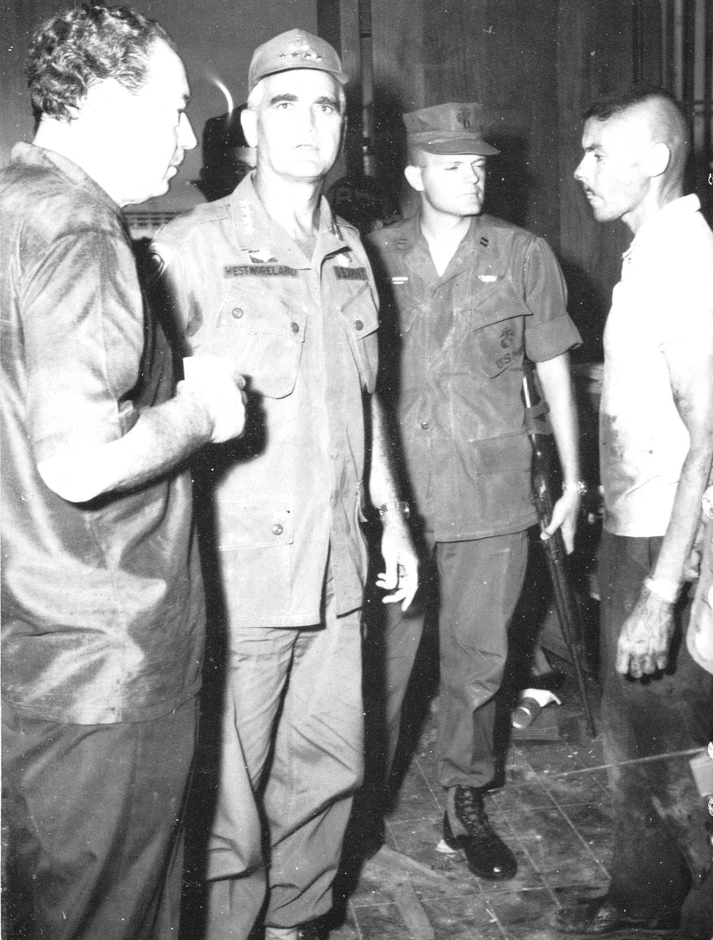
A Washington Post reporter recalls: 'The reporters could hardly believe their ears. Westmoreland was standing in the ruins and saying everything was great.' An AP reporter later explained that, given the record over the years, 'we had little faith in what General Westmoreland stated.' When the American public read their morning papers they received two impressions: the Viet Cong had seized the embassy itself; and Westmoreland was lying when he said they had not. The pyschological damage done to the American war effort would become clearer in the coming weeks.
In spite of complete surprise and the initial success of many of the opening assaults, on the Communist side events were not proceeding as desired. There was no general uprising and little active civilian support in Saigon. In order to preserve secrecy, the VC units that attacked Saigon had little knowledge of the overall picture. Most had received the briefing that they were to take part in an attack of unspecified dimensions. However necessary for security reasons, this secrecy prevented all unit co-ordination. Thus, while achieving numerous isolated initial successes, once in position the VC had to fend for themselves against a growing Allied counter-attack.
Repulsed or evicted from their six prime objectives, the attackers broke down into small units and took shelter in buildings throughout Saigon. In particular, the attackers clung to the Phu Tho racetrack area. The 6th BT VC Battalion had seized the racetrack during its opening assault. Communist planners valued this objective because it was the hub of several major roads, possession of its open terrain denied the Allies a potential landing zone for helicopters bringing reinforcements, and it provided an easily recognized rallying place for rural VC unfamiliar with Saigon.
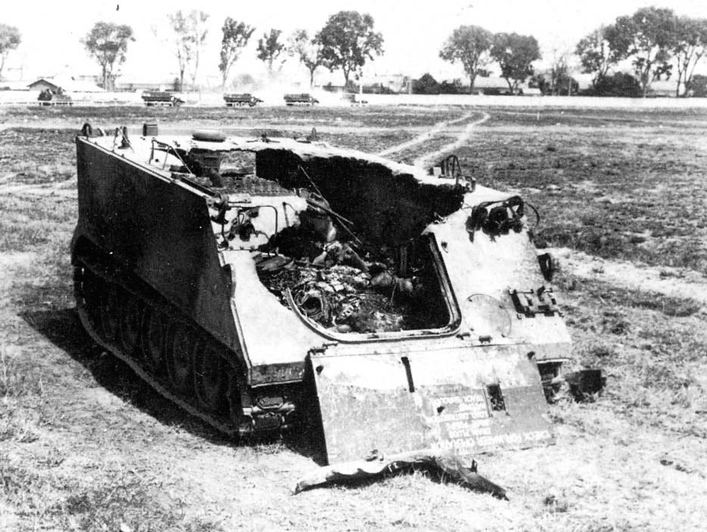
Westmoreland at the Embassy on the morning of 31 January.
A burned out M-113 on the Phu Tho racetrack. The APC was hit by VC rocket fire.
The first warning of the enemy build-up in the Phu Tho area came at 4.45am when a 716th MP jeep patrol radioed: 'The driver caught a slug in the gut and I'm under heavy automatic weapons fire. Can you give me some help?' Then the radio went dead. Before help arrived the two MPs had been killed.
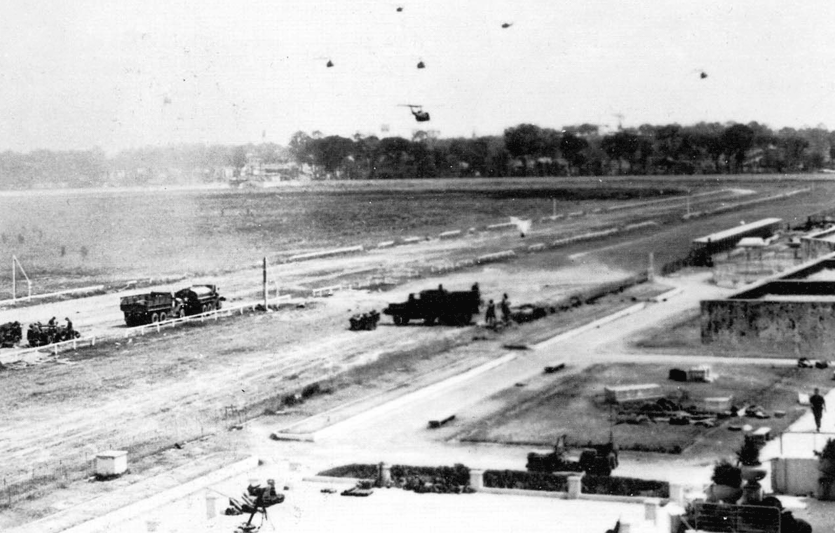
As late as 10 February, US reinforcements, including these soldiers of the 199th Light Infantry Brigade, were still reinforcing the Phu Tho position. The trucks arc parked on the running surface.
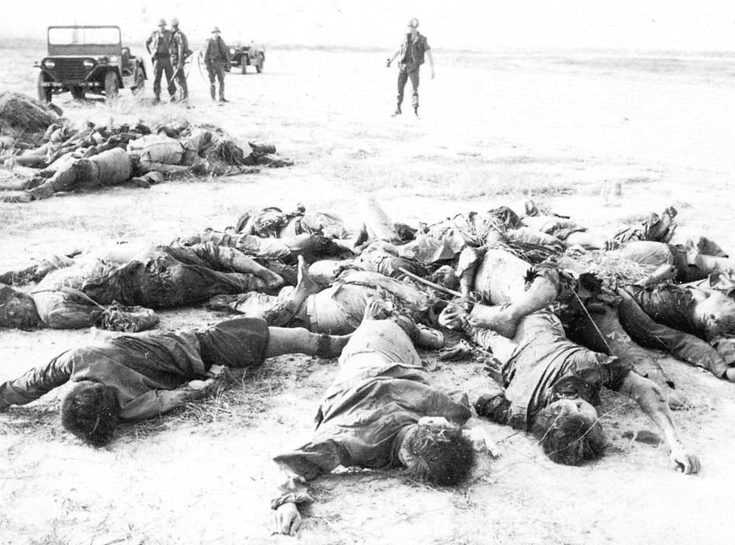
Dead Viet Cong on perimeter of Tan Son Nhut Air Base, 1 February.
A company from the 199th Infantry Brigade (Light) boarded trucks and APCs and headed for the racetrack at 8.00am on 31 January. Six blocks from the objective it met heavy automatic weapons fire from rooftops and buildings lining the road. A VC rocket struck the lead APC killing the platoon leader and two crew. VC rifle, machine-gun, and grenade tire hammered the column as it slowly advanced towards the racetrack. When heavy enemy fire repulsed its first charge, the infantry regrouped and tried again. Supported by helicopter gunships and recoilless rifle fire, they captured the racetrack by 4.30pm. At dusk a reinforcing company landed on the racetrack itself and the Americans prepared a defensive perimeter.
Over the next several days additional reinforcements arrived, including the 33rd ARVN Ranger Battalion, and together the Allies expanded their control to the areas adjacent to Phu Tho. It was not easy. An American mechanized company, driving through a narrow street three blocks away, suddenly was hit by a VC rocket and machine-gun ambush. The opening barrage destroyed the two rearmost APCs and heavily damaged a third. However, its crew stood by their guns to provide covering fire while the accompanying infantry dragged the dead and wounded clear of the kill zone. Then the survivors hustled back to the racetrack itself just in time to help repulse a large-scale VC counter-attack. The fighting ebbed and flowed around Phu Tho for several more days. Eventually, every Viet Cong unit that participated in the Saigon offensive contributed manpower to this battle.
As early as 1 February, COSVN, the Communist high command, realized that many elements of its grand plan had miscarried. While complimenting its soldiers for their performance, it sent out orders that called off further assaults against fortified Allied positions. Furthermore, it criticized faulty co-ordination and liasion and noted serious tactical shortcomings. None the less, not until 7 March, five weeks after the first attack, did ARVN Rangers finally clear the entire capital city of Saigon.

AVRN Ranger, Saigon. Illustration by Mike Chappell.
While the Saigon and Hue battles monopolized most attention from Allied commanders and the Press, fierce Communist assaults took place all over South Vietnam. Here ARVN and militia forces bore the brunt of the ground defence. Part of the ferocity derived from the briefings given to many of the assault troops. They were told that they were engaged in an offensive that was to lead to a general uprising. In keeping with this brave talk, about half the assault units did not receive any instructions regarding a withdrawal in the event of unforeseen circumstances.
While South Vietnamese authorities failed to disseminate word of the cancelled truce in Saigon, in the smaller provincial and district towns some units were on full alert. This made a great difference when the Communists struck. After the event, high-ranking South Vietnamese and American officers would claim that official policy called for holiday leaves for only ten per cent of all manpower. In fact, a much more liberal policy was in effect. Typical was the 7th ARVN Division, which had 4,000 men present and 3,500 on leave when the attack came.
The first assault wave utilized local VC units, sappers, and in-place agents. The Communist attacks strove to disrupt further South Vietnamese improvements by targeting headquarters, training and logistical bases. Every attack also featured an assault against the local radio station. Just as in Saigon, the attackers carried tapes to broadcast in hopes of stirring up the popular uprising. In general, the attacks' success depended upon two conditions: were the defenders alerted with leaves cancelled and in position; were the Americans able to bring their heavy firepower to bear even at the risk of civilian losses?
The abortive assault on Da Nang, the country's second largest city, demonstrated this point. A police agent who had infiltrated the local VC organization warned of the coming blow. None the less, a reinforced company briefly penetrated the headquarters of the South Vietnamese I Corps on the city outskirts. When the dashing corps commander, Lieutenant General Hoang Xuan Lam, first heard from a staff officer that an assault was under way he responded incredulously: 'Baloney, baloney!' Assured that it was true, he drove through enemy fire to reach his headquarters at dawn. Assessing the situation, Lam tapped the map with his swagger stick and spoke to his U.S. adviser, Major P.S. Milantoni:
'Milantoni, bomb here. Use big bombs.'
'General, that's pretty close.'
'Bomb.'
The adviser requested the mission only to be told by another American officer that the mission was so close to friendly positions that it would never get clearance. Milantoni replied: 'General Lam just gave it.' The bombs struck a mere 200 yards from I Corps headquarters. The VC fire diminished and Lam ordered more strikes. When the VC pulled back, the South Vietnamese general sent helicopter gunships in pursuit. The VC attack on Da Nang failed.
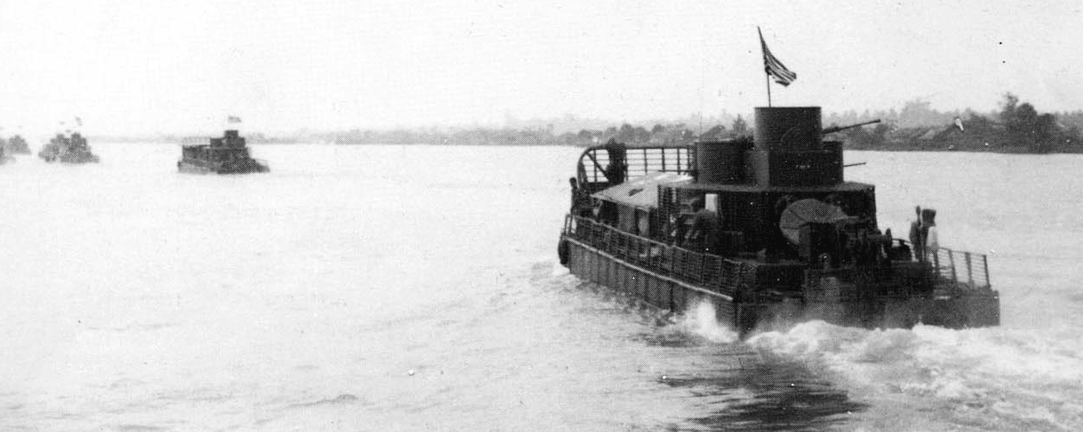
Few American units operated in the heavily populated Delta region south of Saigon. The notable exception was the joint Army/Navy Mobile Riverine Force (MRF). Built around two brigades of the 9th Infantry Division, the MRF had unique assets suitable for the labyrinth of rivers, canals and rice paddies characteristic of the Delta. In most of Vietnam, the Allies used helicopters to reach the enemy in otherwise inaccessible terrain. In the waterlogged Delta, the Allies employed specially designed water-craft. They included armoured troop carriers known as Tango boats after their call sign. The Tango boat featured stand-off armour designed to detonate RPG or recoilless rocket rounds before they hit the boat's armour. Used as assault craft, the Tango boats glided through the shallows to land infantry on dikes and levees.
The Mobile Riverine Force (MRF) was a special American brigade-sized outfit equipped for the unique combat conditions in the Mekong Delta. It moved through the myriad rivers and canals aboard assault boats and possessed numerous improvised weapons such as 60-foot long monitors armed with a revolving armoured turret housing a 40mm cannon intended for close fire support. It had specially designed floating artillery barges to provide heavier firepower. All of these weapons and more were attempts to solve the constant problem of the Vietnam War, how to find and fight an elusive enemy who usually revealed himself only when his first shots announced an ambush. When the Tet Offensive exploded in the Delta, the problem was not locating the enemy. The Viet Cong seemed to be everywhere.
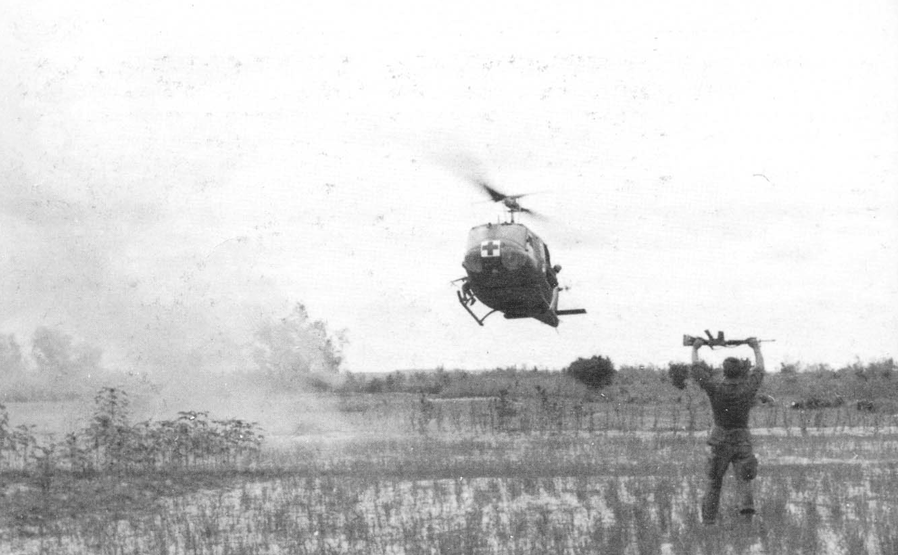
In the Mekong Delta, the Communists assaulted thirteen of sixteen provincial cities. Such was the ferocity of their attacks that Allied intelligence soon identified all except one battalion listed on its order of battle. In other words, the Communists were sending in all their men. Furthermore, captured plans revealed a notable absence of the customary contingency plans for retreat. Apparently the attackers planned to hold their ground. The MRF, on the other hand, manned dispersed positions along waterways in an effort to interdict VC supply lines. Units had to concentrate hastily before counter-attacking VC penetrations in various urban settings.
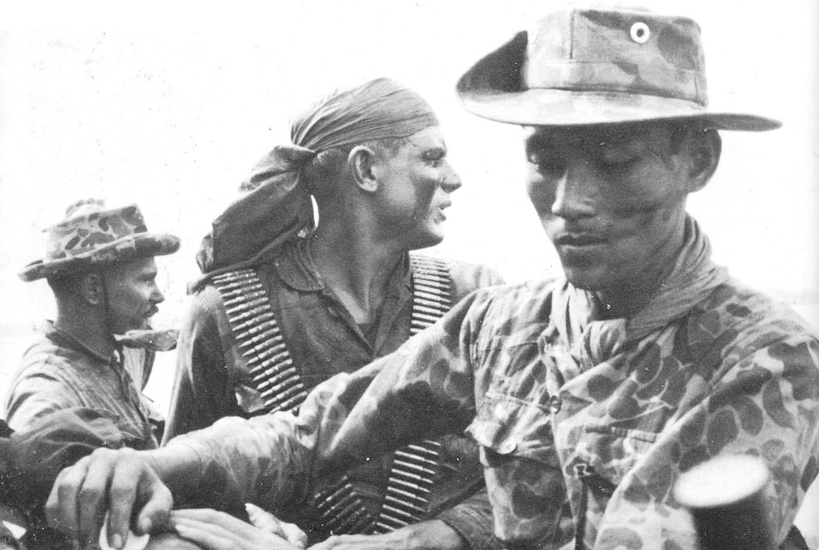
Their first call was to My Tho, south of Saigon. Three VC battalions and a sapper company had entered the city while one battalion remained on the outskirts. Two MRF battalions hastened to the city to support the units of the embattled 7th ARVN Division. It took three days to recapture My Tho. The battle featured tough house-to-house fighting, a type of combat very different from the MRF's normal mission and one unsuited to its special weaponry. Like a fire brigade, once it had secured My Tho, MRF units rushed to other threatened positions including Saigon itself.
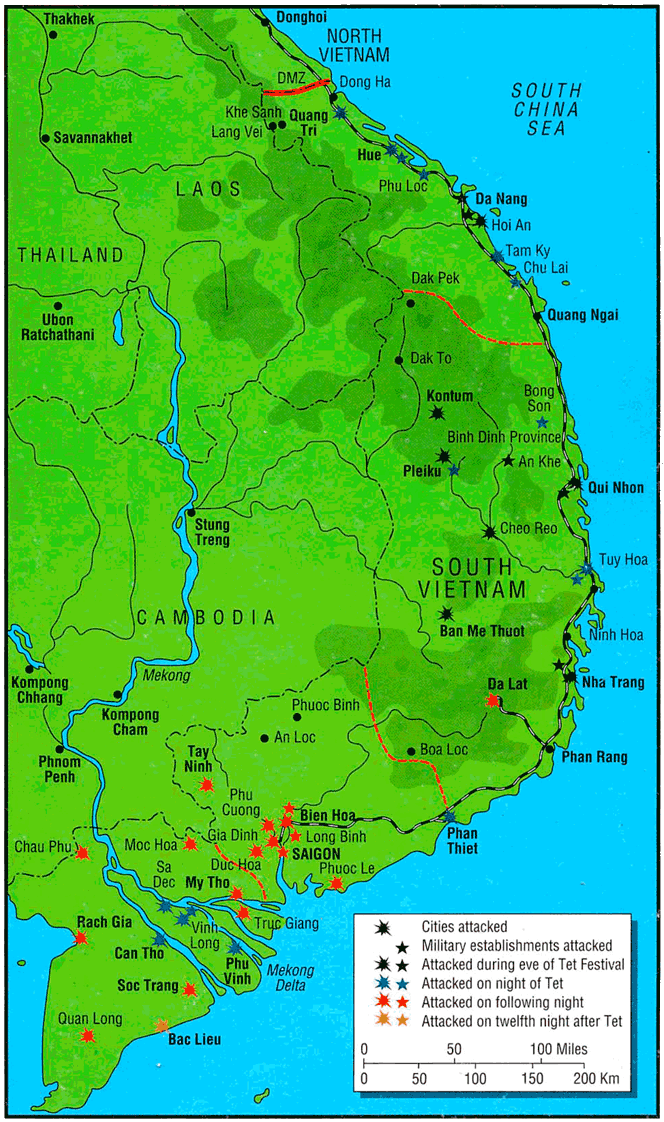
Targets of the Tet Offensive
The heavy lighting during Tet strained the sen ices of the living ambulances. Using the famous call sign 'DUST OFF', pilots time and again took extreme risks to rescue the wounded. Their dedication, coupled with superior hospital facilities gave wounded Americans and their allies an unprecedented survival rate. Over the entire war, the average time-lapse between wounding and hospitalization was less than one hour. Consequently, 99 per cent of all American wounded who survived the first 24 hours lived. Pilots and crew paid a stiff price for their gallantly. During let's 12-day period of nationwide fighting, they evacuated more than 8,000 wounded. Forty of the total of 64 operational 'DUST OFF' helicopters were hit.
The VC made the mistake of attacking Chau Phu, a provincial capital on the Cambodian border. Opposing them were some of the roughest fighters in all South Vietnam. They included small but deadly teams of the Special Forces Detachment B-42, a Project PHOENIX recon unit, and Navy SEALs shown here. These élite men recaptured Chau Phu in a bitter 36-hour combat that caused many civilian losses and destroyed a quarter of the city.
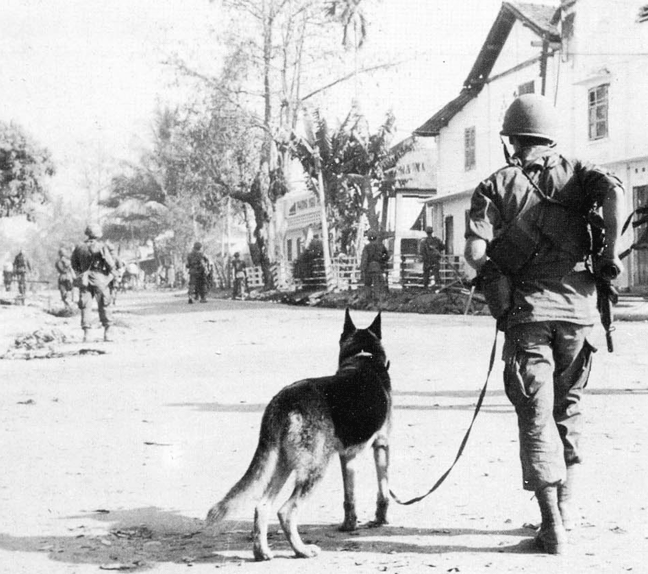
A scout dog team belonging to the 4th Infantry Division Hushes out enemy snipers still clinging to Kontum five days after the Communists attacked the city.
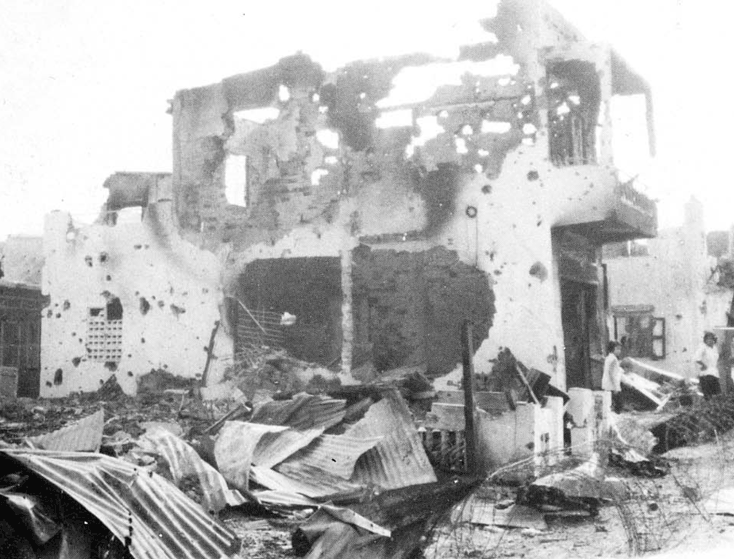
In the war against the French, the Vietminh had successfully recruited sympathizers by entering urban areas and forcing the French to employ heavy weapons to drive them out. They then blamed the civilian losses on the French. By occupying churches, pagodas, schools and hospitals, the Communists created the same dilemma for the Americans during the 1968 Tet Offensive. Vietnamese civilians return to their destroyed homes near Bien Hoa on 2 February.
For an unprecedented thirty consecutive days the Mobile Riverine Force fought without rest. Its contributions were key to the many tactical successes gained in the Delta. General Westmoreland, taking a typical American view that undervalued ARVN fighting, said afterwards: 'The MRF saved the Delta.' Indeed, its stout fighting justified the Presidential Unit Citation it earned. Still, here as elsewhere, tactical success could not conceal the hard truth that the Viet Cong had demonstrated to the civilian population of the Delta that, despite American support, they could strike anywhere, anytime. Since ultimately the war would have to be won or lost through the effort of the South Vietnamese, this demonstration contributed to Communist strategic victory.
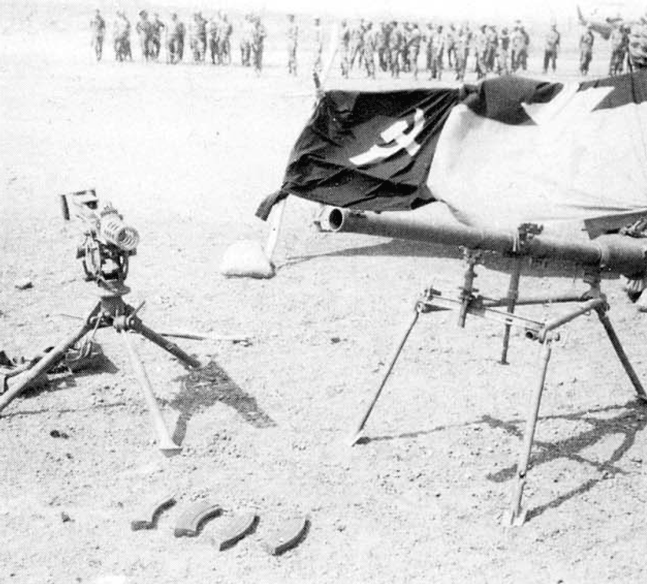
Captured .50cal machine-gun and Soviet-made rocket launcher mounted on stand. In background are two captured flags.
An MRF boat captain well understood the consequences of the Tet Offensive in the Delta: 'After Tet this whole country really changed.' Speaking of a town badly damaged in the fighting, he continued: 'The VC really tore the place up and I think the Americans more or less got blamed for it. We had to evacuate the town and when we did go back... there were quite a few Vietnamese people around who kind of looked down on us a little for leaving them.' Supporting this captain's analysis was the experience of the Mekong Delta river city of Ben Tre, which was home to some 35,000 civilians. A reinforced VC regiment numbering about 2,500 men attacked and gained substantial footholds within the city. To evict the Viet Cong, the Allies had to summon artillery and air strikes. This caused extensive damage to the city and produced one of the most memorable quotes of the war. While explaining what had taken place to a reporter, an American major said: 'It became necessary to destroy the town to save it.' The American Press played this quote to the hilt, using it to epitomize the seeming futility of the war effort.
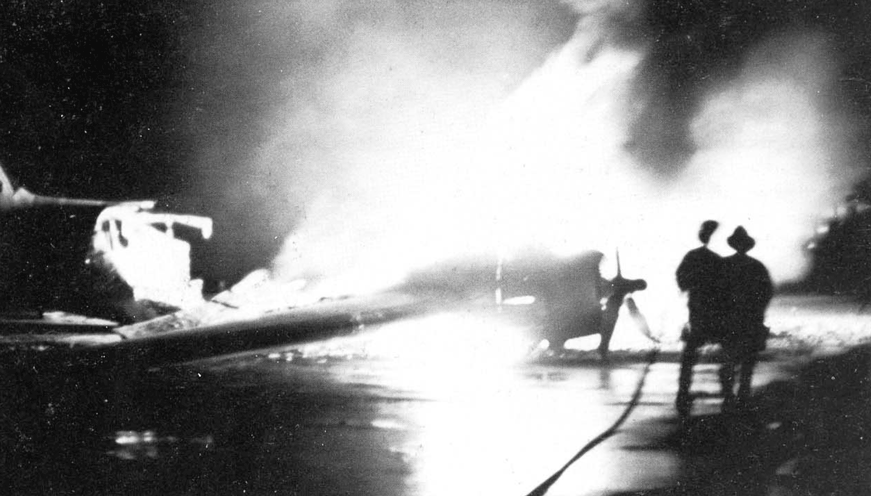
Having suffered terrible losses, the VC reverted to more economical tactics. A Vietnamese C-47 destroyed in the artillery attack on Tan Son Shut Air Base the night of 17/18 February.
Fierce fighting also took place in the twelve central provinces. Major ground attacks struck seven provincial capitals and three other objectives. At Qui Nhon, a coastal city in II Coips area, before the attacks began, the ARVN defenders discovered the Communist plan when they captured eleven VC agents. But such was the muddle within South Vietnamese units at Tet that Communist sappers assaulted exactly as revealed and still seized their objectives. The attackers even seized the jail, where they captured the ARVN captain who had directed the successful raid that had bagged the eleven agents.
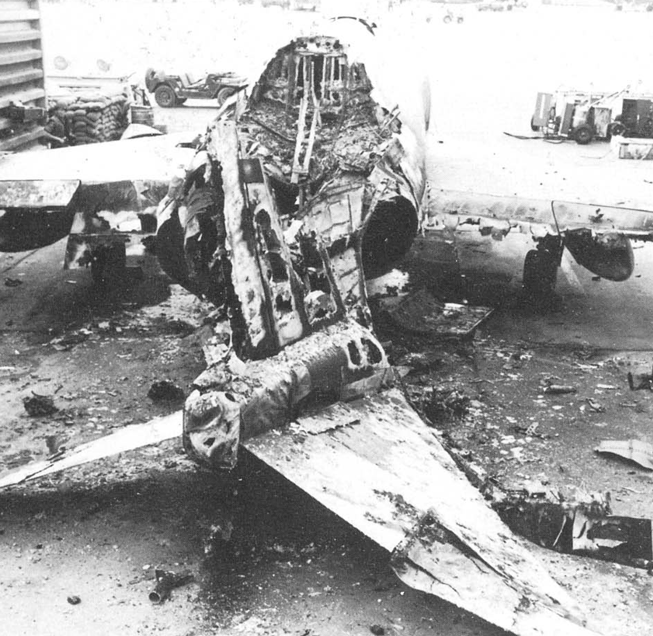
Another victim of the artillery attack at Tan Son Nhut, a F-4C Phantom II.
Typical was the battle of Ban Me Thuot in the Central Highlands. Here the 23rd ARVN Division had captured a plan for an attack on the city on about 20 January. The divisional commander, Colonel Dao Quang An, accordingly cancelled his unit's Tet leave. He put out patrols six miles from the cits', and these patrols ambushed elements of the 33rd NVA Regiment as they were moving into position. None the less, the fighting at Ban Me Thuot raged for three and a half days, with the ARVN soldiers taking heavy losses because of their inexperience in city fighting. Reluctantly, An decided he had to employ artillery and air strikes despite the resultant civilian devastation. Yet the battle continued for a solid nine days, the city centre changing hands four times before the 23rd ARVN Division regained control. An's leadership greatly impressed the Americans. An adviser commented that had he not decided to cancel Tet leaves and to deploy far-ranging ambush patrols, the city would have fallen. Further, the adviser told MACV that An's tactical handling of the battle had been flawless.
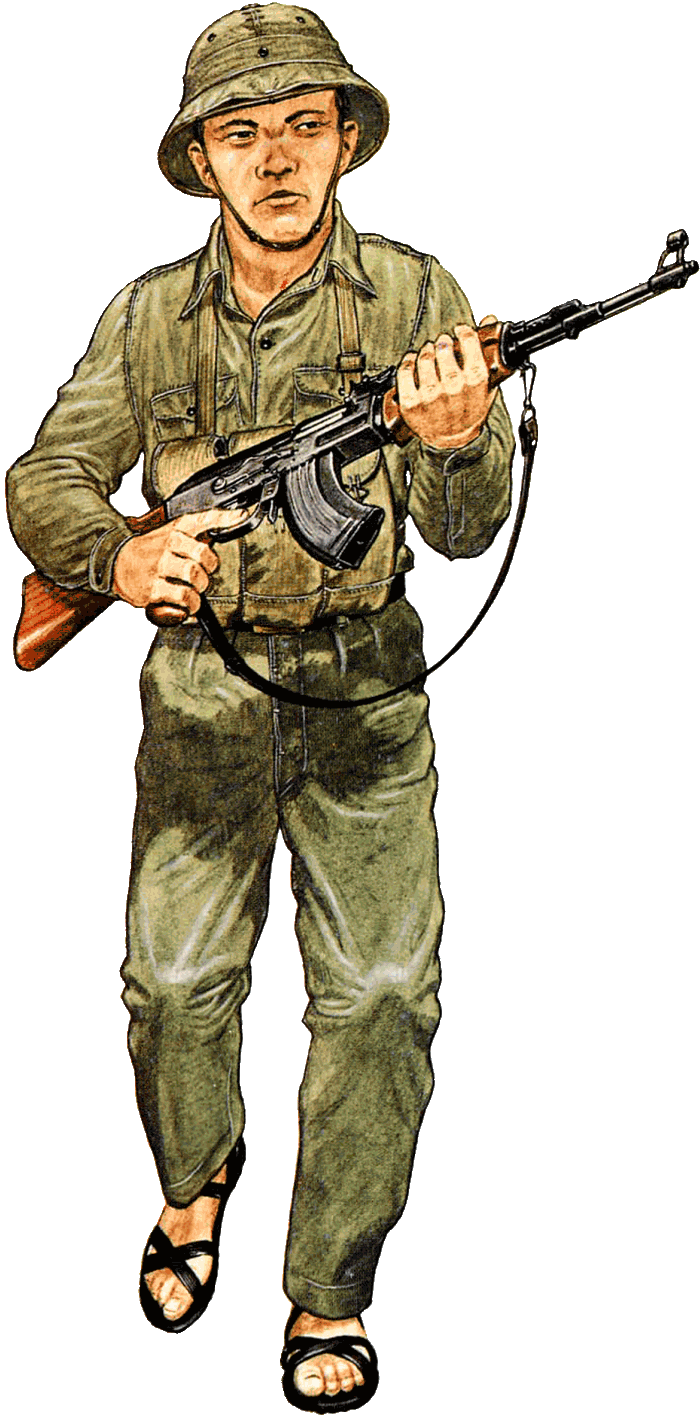
Typical soldier of the North Vietnamese Army. Illustration by Mike Chappell.
In sharp contrast was the conduct of the major general commanding in the delta. When the attack struck he was at his fortified headquarters protected by tanks and armoured infantry. He did not emerge for days, leaving his American advisers to conduct the defence. Similarly, the ARAN colonel commanding at Vinh Long cracked under the strain of events. When an American officer reported helicopters receiving fire and asked permission to return fire, all he received was a blank stare. Another adviser found the province chief wearing civilian clothes under his military uniform - just in case.
Despite heavy fighting in many places, Allied units regained control in most provincial cities within a week. On 7 February, NVA tanks spearheaded an assault that overran the Lang Vei Special Forces Camp near Khe Sanh. With hearts in their throats, the American high command wondered if this were the start of the long- expected attack on Khe Sanh. Perhaps it was just another diversionary attack against a convenient and exposed target, because the Communist high command chose not to try to exploit this success. On 17-18 February the Viet Cong created a brief stir when they made artillery assaults against Allied installations throughout the country. But in comparison with the initial operations, these were low effort/low risk harassing affairs. After the first week sustained combat took place only in Saigon and Hue.
By 21 February, the VC/NVA high command faced battlefield reality. Their assaults had been extremely costly and had failed to achieve the predicted success. Accordingly, COSVN issued orders for its units still in contact around the cities to retreat. There were to be no more ground assaults on fortified Allied installations. Instead, COSVN ordered units to revert to hit-and-run tactics characterized by mortar and rocket bombardment and sapper raids. COSVN made one exception - the units in Hue were to hold their positions.
We have much more interesting information on this site.
Click MENU to check it out!
∎ cartalana.com© 2009-2025 ∎ mailto: cartalana@cartalana.com